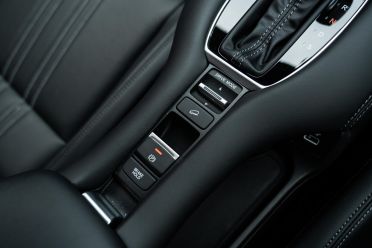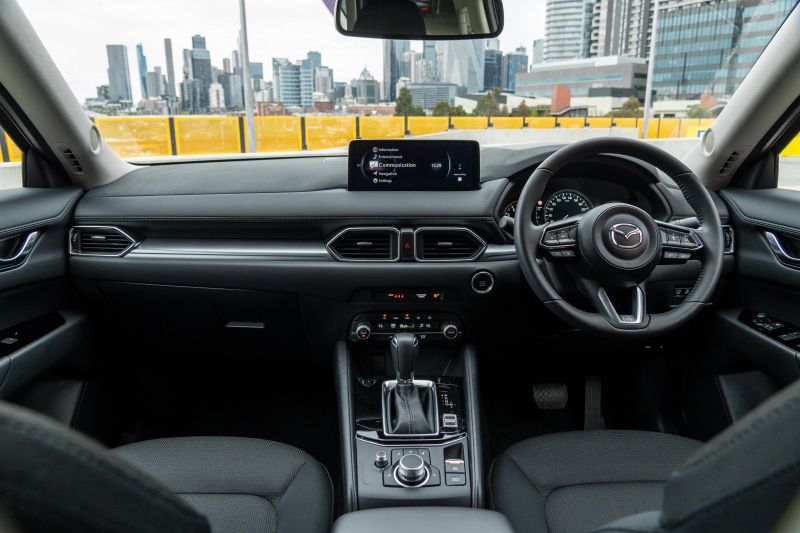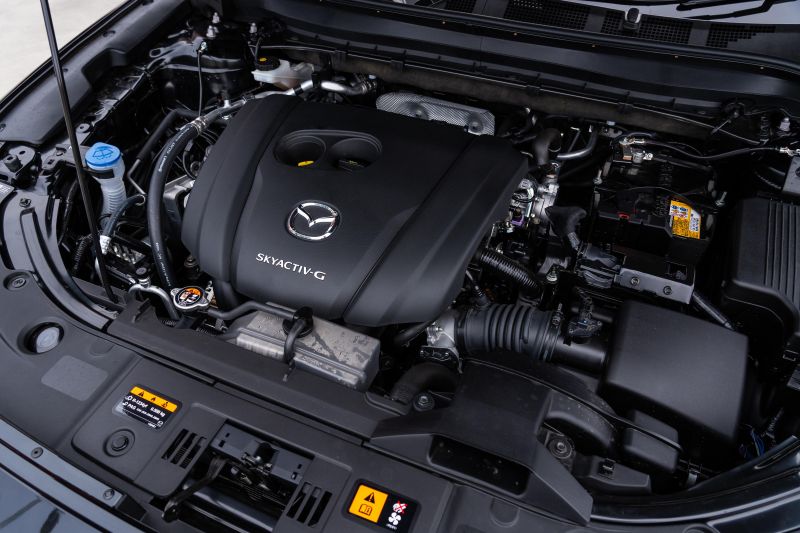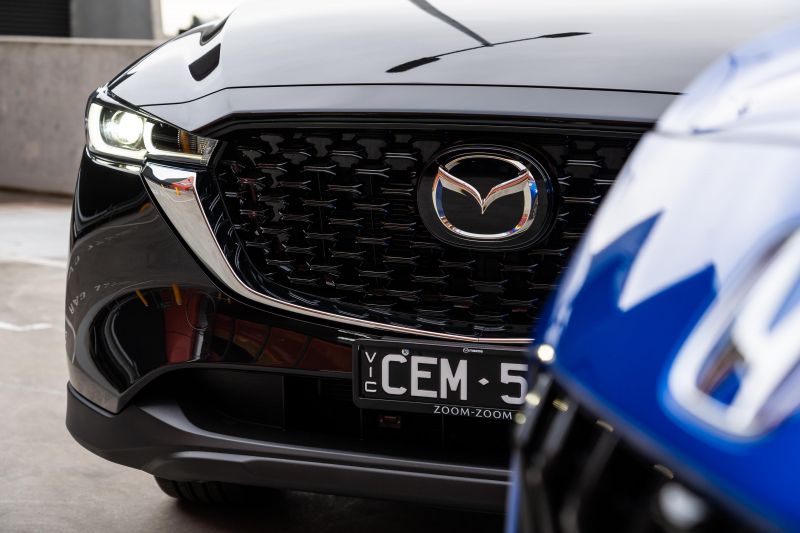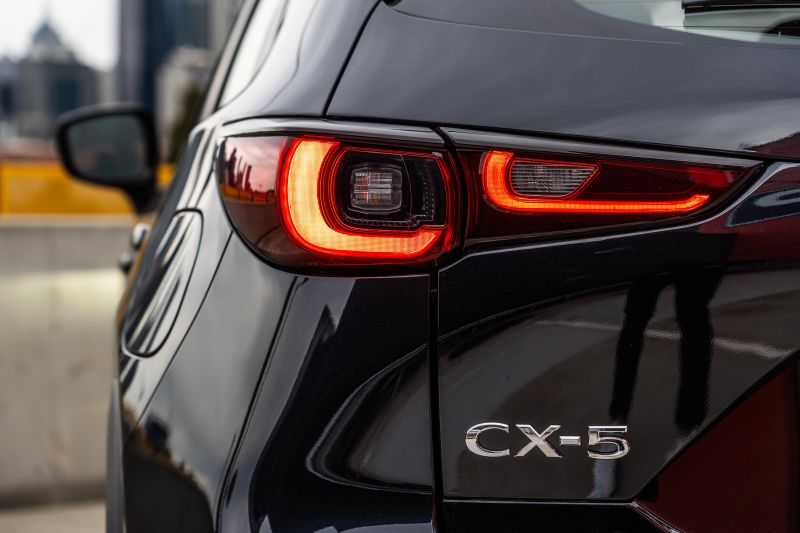The Honda ZR-V has burst onto the scene in Australia’s most competitive new vehicle segment.
Slotting between the smaller HR-V and larger CR-V, both long-running nameplates in the market, the all-new ZR-V aims to be a sportier choice, based on the capable underpinnings of the Civic hatchback.
With the CR-V taking on the likes of the Mitsubishi Outlander and Nissan X-Trail at the larger end of the segment, the strictly two-row ZR-V plays at the smaller end, lining up very well with the top-selling Mazda CX-5.
Both of these crossovers are pitched as more engaging drives in a fairly mundane corner of the market, with the Mazda continuing to be an Aussie favourite on the sales charts despite its advancing age.
The ZR-V is still something of an unknown in its early days on sale, as Honda continues to try and spread awareness of its new model – though it’s hard to miss in our tester’s Premium Crystal Blue paint finish.
For some perspective, the Mazda CX-5 has returned 16,173 deliveries to September 30 this year, while the ZR-V has managed 1166 units since it first launched in July.
We’ve assembled versions of each that can be had in your driveway for less than $50,000. Who wins?
How much?
As just mentioned, the two cars here can be had for under $50,000 drive-away in a market that continues to bump prices up.
The Honda ZR-V VTi LX is the flagship petrol in the range, priced from $48,500 drive-away. Honda Australia has moved to an agency sales model with fixed drive-away pricing nationwide.
Meanwhile, we have a Mazda CX-5 G25 Maxx Sport on test, which starts at $44,480 drive-away for the FWD and $47,080 drive-away for the AWD (both using a Melbourne postcode). Our intention was initially to have a G25 Touring AWD for this comparison, which is advertised for a smidgen over $49,000 D/A.
The Mazda CX-5 range is due for some running changes and price adjustments for the 2024 model year, with diesel options dropped and the adventure-focused G25 Touring Active trim level axed. The MY24 Mazda CX-5 G25 Touring AWD will be priced from $44,920 plus on-road costs, an increase of $620.
What do you get?
Here’s a rundown of each nameplate’s respective trim walks up to the grades as tested here.
ZR-V VTi X highlights:
- Adaptive LED headlights
- Active cornering lights
- 17-inch alloy wheels
- Rain-sensing wipers
- Hill descent control
- 9.0-inch touchscreen infotainment system
- Wireless Apple CarPlay
- Wired Android Auto
- 10.2-inch digital instrument cluster
- 8-speaker sound system
- Black fabric upholstery
- Dual-zone climate control
- Auto-dimming rear-view mirror
- Leather-wrapped steering wheel and shifter
- Upholstered centre console with French stitching
- Front USB ports (1 x USB-A and 1 x USB-C)
- Rear USB ports (2 x USB-C)
- Rear air vents
- Space-saver spare wheel
- 60/40 split/fold rear seats
ZR-V VTi L adds:
- 18-inch alloy wheels
- Heated exterior mirrors
- Hands-free power tailgate incl. walk-away closing
- Rear privacy glass
- Combination LED tail lights
- Black leatherette upholstery
- Heated front seats
- Metal paddle shifters
- LED ambient lighting (roof)
ZR-V VTi LX highlights:
- 18-inch two-tone alloy wheels
- Body-coloured lower bumpers, wheel arches
- Selectable drive modes (Sport, Normal, Economy)
- 12-speaker Bose sound system
- Wireless phone charger
- Satellite navigation
- Black leather upholstery
- 8-way power driver’s seat with memory
- 4-way power passenger seat
- Heated rear seats
- Heated steering wheel
- Sports pedals
- ‘Door Line Illumination’
- Auto-tilting mirrors in reverse
- Plasmacluster air purification system
CX-5 Maxx highlights:
- 17-inch alloy wheels
- Automatic LED headlights
- Automatic high-beam
- Rain-sensing wipers
- Body-coloured side mirrors with power folding
- 7.0-inch TFT CLD digital instrument cluster
- 10.25-inch infotainment system (Mazda Connect)
- DAB+ digital radio
- Apple CarPlay, Android Auto (wireless)
- 6-speaker sound system
- Head-up display
- Two front USB-C ports
- Push-button start
- Air-conditioning
- Leather-wrapped steering wheel
- Leather-wrapped gear shifter
- Electric parking brake with auto-hold
- Keyless window open function
- Black cloth upholstery
- Rear seat reclining function
CX-5 Maxx Sport adds:
- LED tail lights
- Satellite navigation
- Dual-zone climate control
- Rear air vents
- Paddle shifters
- Auto-dimming rear-view mirror
- Rear centre armrest
- Two rear USB-A ports
CX-5 Touring adds:
- 19-inch alloy wheels
- Power-folding, heated exterior mirrors
- Wireless phone charger
- Keyless entry
- Black Maztex upholstery
Are they safe?
Honda ZR-V
ANCAP hasn’t tested the ZR-V yet, and therefore the Honda SUV remains unrated for now.
Standard safety equipment includes:
- 11 airbags
- Dual front, knee airbags
- Centre airbag
- Front and rear side airbags
- Full-length curtain airbags
- AEB incl. Pedestrian, Cyclist detection
- Adaptive cruise control with low-speed follow
- Driver attention monitoring
- Lane departure warning
- Lane keep assist
- Parking sensors front, rear
- Road Departure Mitigation
- Traffic Jam Assist
- Traffic sign recognition
- Tyre pressure monitoring
ZR-V VTi LX adds:
- Blind-spot monitoring
- Rear cross-traffic alert
- 360-degree cameras
Mazda CX-5
The Mazda CX-5 wears a five-star ANCAP safety rating based on testing carried out in 2017.
It scored 95 per cent for adult occupant protection, 80 per cent for child occupant protection, 78 per cent for pedestrian protection, and 59 per cent for safety assist.
Standard safety equipment includes:
- 6 airbags
- Autonomous emergency braking (AEB)
- Forward/Reverse (4-80km/h)
- Pedestrian detection (Forward)
- Blind-spot monitoring
- Rear cross-traffic alert
- Lane departure warning
- Lane keep assist
- Driver attention alert
- Auto high-beam
- Adaptive cruise control (all models) with stop/go (AT only)
- Reversing camera
- Rear parking sensors
- Tyre pressure monitoring
CX-5 Maxx Sport adds:
- Traffic sign recognition
CX-5 Touring adds:
- Front parking sensors
CX-5 GT SP adds:
- Adaptive Front-lighting System (AFS)
- Active bending headlights
- Cruising and Traffic Support
- Adaptive cruise + lane centring function
CX-5 Akera adds:
- 360-degree camera system
- Adaptive LED headlights
- incl. adaptive high-beam
What are they like inside?
Honda ZR-V
Build quality and tactility is up there with some of the best, with heaps of soft-touch surfaces and padded, stitched leatherette trim accents. This is Honda’s new SUV flagship in Japan, and it feels it.
The VTi LX grade brings luxury features like powered and heated front seats, a heated steering wheel, embedded satellite navigation for the 9.0-inch touchscreen infotainment system, and a thumping 12-speaker Bose sound system.
The range of powered adjustment for the driver and the comfortable front chairs mean you can find a good driving position easily easily and feel supported on longer drives. The seats are fairly low which makes the ZR-V feel more car-like – something to consider if you’re after a more commanding SUV view out.
Ahead of the driver is a 10.25-inch digital instrument cluster which is standard across the ZR-V line-up. It’s simple and has cute graphics and animations – the little virtual ZR-V mirrors your lights and indicators. While it’s not as configurable as some European makes, it’s more sophisticated than the Mazda’s 7.0-inch virtual centre dial.
The 9.0-inch touchscreen infotainment system gets navigation in this specification, bolstering the standard wireless Apple CarPlay and Android Auto. Response and load times are good, and the overall user interface is very clean and easy to use.
While it has touchscreen functionality unlike the Mazda, it doesn’t have a supplementary controller like the CX-5’s rotary controller.
Honda Connect is standard across the range, with a five-year complementary subscription included with purchase. It offers a range of services that are accessible via a smartphone app, incorporating convenience and safety functions.
Mazda currently doesn’t offer net-based connected services yet in Australia, though will commence the rollout of online functions and app-based functions in 2024 starting with the updated MX-5 sports car.
Honda Connect highlights:
- Remote functions
- Climate control pre-conditioning
- Lights on/off
- Remote lock/lock
- Automatic collision detection
- Speed Alert
- Vehicle status
- Emergency call
- Virtual dashboard
- Location finder
- Trip log
- Geofence alert
- Push notifications and messages
Storage up front is up there with the best in the class, with a slew of smart solutions.
The bridge-type centre console has a little cubby under the electric park brake, and the shelf ahead of the shifter has a wireless phone charger pad.
Big bins in the doors can accommodate larger bottles, and there’s a cubby under the front-centre armrest that’s also handy for hiding things out of sight.
I’m also a big fan of the solid, clicky feel of all the switchgear and dials, which is really high end. In particular, the knurled climate control knobs are a tactile delight, and remind me of Audi units.
The rear seats are pretty good, which is expected given this shares its DNA with the Civic hatchback. There’s good head-, knee- and legroom for taller occupants – like me at 6’1 – even behind my own driving position.
Two adults will be more than happy back there, while the skinny centre seat means a third occupant will be a little short changed. At least there’s an almost flat floor in the year which frees up more foot and toe room.
Further, the middle seat also gets a ceiling-mounted seatbelt which seems old-hat for a new car in 2023. The outboard seats also have ISOFIX anchors, while all three rear positions have top-tether points.
Amenities in the rear include directional air vents behind the console, map pockets behind the front seats, bottle holders in the doors, as well as a fold-down centre armrest with cupholders.
Perhaps the ZR-V’s only real drawback against competitors in the segment is its below-average luggage capacity, which at 370 litres (VDA) in VTi LX specification is trailing the CX-5 (438L). VTi X and VTi L grades score 10L extra.
Drop the seats down and you get 1302L-1312L (VTi LX-VTi X/L), which is more substantial and competitive with rivals. Further, the already wide and square space is bolstered by a well-designed flat load bay – though no Magic Seats, for those asking.
Petrol (VTi) versions of the ZR-V all come with a 17-inch space saver spare wheel, compared to the e:HEV hybrid’s tyre repair kit.
Mazda CX-5
Even in this one-up from base grade, the CX-5 has quite an upmarket feel.
With squidgy, stitched leatherette accents for the upper sections of the doors and dash, high-quality touch points and a clean approach to ergonomics and switchgear.
It’s really not all that different to Honda’s refreshed approach to interior design, but the fact the CX-5 is now some six or seven years old really speaks to the timeless approach employed by Mazda here.
The clean, consistent typeface used for switchgear labelling as well as the classic white backlighting again add a touch of class.
If you want genuine leather in the CX-5 you have to spend up to the GT SP or Nappa-trimmed Akera grades, although the Touring offers leatherette upholstery which is quite nice – if you opt for an MY23 model you get Maztex/Suede, but MY24 is Maztex only.
That said, the cloth trim in the Maxx Sport tested here looks and feels high quality, and is comfortable to sit in. I personally prefer cloth and suede trims, but I understand parents prefer leather surfaces as they’re easier to clean when kids make a mess.
Mazda beats Honda in the display real estate stakes, with a wider 10.25-inch high-set screen offering competitive loading speeds and resolution, and with an interface that is arguably cleaner and more high-end in presentation.
It also matches the ZR-V’s Honda Connect unit for features bar online services, which could be a sticking point for those wanting connected navigation with traffic updates, as well as remote functions via a smartphone. Mazda will start rolling out these features throughout its line-up next year, but we’re not sure when for CX-5 yet.
Storage is perhaps one area where the CX-5 is showing its age, with fewer cubbies than the Honda – and smaller, less convenient ones at that.
The Maxx Sport doesn’t get a wireless phone charger in the slot designed to stow phones and wallets – you need to get the Touring for that – and there’s no clever under-console storage like the ZR-V.
Both cars have similarly sized door bins, however, and there’s a decent cubby under the padded front-centre armrests. One thing to note is the CX-5’s front cupholders are positioned where your elbows rest instead of ahead of the shifter like the ZR-V, which may get in the way if you’re driving with a taller bottle or cup stowed there.
Neither SUV is a manual though, so the latter is less of a problem here.
The Mazda CX-5 has never been a class leader for rear accommodation, given it competes with larger and boxier crossovers like the RAV4 and X-Trail, but within this comparison it’s hardly a poor showing.
A pair of adults will fit back there just fine, kids even better. Like the ZR-V – and arguably most vehicles in this segment – the middle seat is more of an occasional use pew, but at least the base is nice and flat. The driveline hump is a little larger than the Honda’s but still not too intrusive on foot space.
If you need to carry long items the CX-5’s 40:20:40-split rear seats are more practical than the ZR-V’s 60:40 backrest, and the centre seatbelt is built into the seat rather than the ceiling. The USB charging ports are built into the fold-down armrest rather than the centre console, which is fine for four passengers, not so much five.
Rounding out the amenities are ISOFIX and top-tether points for child seats, and bottle holders in the doors – effectively matching the ZR-V.
Mazda quotes 438L of cargo capacity with the second row in use, which expands to 1340L with them folded. Both figures better the Honda.
When folded, however, the CX-5’s load bay isn’t quite as flat as the Honda’s. All versions of the CX-5 feature a temporary space saver spare wheel under the boot floor.
What’s under the bonnet?
Honda ZR-V
VTi-badged versions of the Honda ZR-V are powered by a 1.5-litre turbocharged four-cylinder petrol engine. You can also get an e:HEV LX version with a 2.0-litre petrol-electric hybrid drivetrain.
Shared with the Civic, the VTEC Turbo unit produces 131kW (6000rpm) and 240Nm (1700-4500rpm), with all versions in Australia sending drive to the front wheels via a CVT automatic – AWD is available overseas.
Honda quotes combined fuel consumption of 7.2 litres per 100km in this specification, with CO2 emissions rated at 175g/km. Despite being homologated to Euro 6b emissions standards, local ZR-V models miss out on idle stop/start.
The ZR-V can take 91 RON regular unleaded fuel in its 57-litre fuel tank.
Mazda CX-5
The ‘G25’ designation in the Mazda CX-5 range means a 2.5-litre naturally aspirated four-cylinder petrol engine under the bonnet.
It’s rated to produce 140kW (6000rpm) and 252Nm (4000rpm), making it more powerful and torquier than the Honda on paper but requiring more revs to hit its sweet spot.
Drive in our test car is sent to the front wheels via a six-speed automatic transmission. On-demand all-wheel drive with an off-road mode is available as an option.
Fuel consumption is rated at 7.2L-7.4L/100km (FWD-AWD) for the CX-5 G25, with CO2 emissions quoted at 167-172g/km. All CX-5 models are homologated to Euro 5 emissions standards, and are fitted with idle stop-start tech.
The CX-5 can run on 91 RON regular unleaded, with the fuel tank measuring 56 litres in FWD models and 58L in AWD versions.
How do they drive?
Honda ZR-V
With torquey turbo power and a CVT automatic, the ZR-V has plenty of pep for everyday driving, and is deceptively quick in a straight line. It doesn’t quite feel as tied down as its Civic sibling, focusing instead on everyday comfort and refinement. For the most part it really delivers.
The driver controls are responsive and accurate, inspiring confidence whether you’re pottering around town or cruising on the freeway, and the hunkered-down stance really helps that feeling of security at high speeds.
Driven sedately in town, progress is effortless and there’s minimal intrusion of engine noise into the cabin compared to the rev-happy, naturally aspirated Mazda. Honda’s CVT doesn’t really simulate the steps of a conventional automatic unless you’re going full throttle, so it can sound a little slurry or droney in normal driving.
I’d also suggest not relying on the paddle shifters, as the CVT just cannot match the Mazda’s six-speed auto for shift crispness and response – it’ll still slur through its virtual ratios and doesn’t sound great doing it.
Even on its bigger wheels compared to the entry VTi X variant, the ZR-V rides really well. There’s good suspension travel to iron out the lumps and bumps of city streets, and the body is well controlled through successive undulations.
There’s a slight slapping feel over sharper hits, but it’s far from unrefined or unresolved. I was very impressed with the ride, which doesn’t really sacrifice handling capability. Like the CX-5 there’s some body roll but it’s far from wobbly, and feels sportier than something like a RAV4 or X-Trail.
Road noise remains a weak spot for most Hondas, though the latest cars have improved over previous generations. Tyre roar is present but not overbearing on coarse roads, and driven back-to-back with the CX-5 the ZR-V felt noisier with its 225/55 Yokohama Advan tyres.
Wind noise is well suppressed though – no doubt helped by the ZR-V’s slinky profile and skinny mirrors relative to some other mid-size SUVs.
Adaptive cruise control with ‘Low Speed Follow’ and an active lane centring function allow for semi-autonomous highway driving; as I’ve found with Hondas in the past it can be too conservative with vehicles entering your lane ahead though. It shadow braked a few times without warning, which was quite frustrating.
It’s otherwise well sorted in traffic jams, and the lane centring function didn’t feel like it’s wrestling the wheel out of your hands. Proper blind-spot monitoring and rear cross-traffic alert are pluses.
I do lament the lack of idle stop-start tech, however, which leaves the ZR-V sipping away in traffic. It meant that, unlike the Civic, fuel consumption ballooned around town into the 9.0s and nearly 10L per 100km, which is a fairly stark contrast to the 5-6L/100km you can achieve on the highway.
Mazda CX-5
She may be getting on a bit, but the Mazda CX-5 remains one of the driver’s picks in the mid-size segment.
It has that same rev-happy, zoom zoom nature we’ve come to love from the company’s wider range, and there’s a sporty and dynamic flavour that doesn’t come at the cost of all-round comfort and refinement.
The more elevated driving position and taller proportions fell more like a conventional SUV than the car-like Honda, but the fluid steering, responsive throttle and playful dynamics are all a match for its Japanese compatriot.
Even this relatively entry-level CX-5 Maxx Sport feels incredibly well rounded, from the strong performance in normal driving from that free-revving 2.5-litre motor, to the wonderfully cushy ride and playful levels of body roll akin to the MX-5 sports car – the CX-5 can do it all.
Compared to the Honda it felt more refined and comfortable, whilst also being more engaging to drive. Years of running changes have made for quite a polished product – where the ZR-V is something of a solid first attempt.
It also ended up being more efficient, partly due to the fact it features fuel-saving idle stop-start tech that paid dividends in traffic, as well as cylinder deactivation which shuts down two cylinders under low loads to save fuel.
The CX-5 stayed in the low-8.0L/100km bracket during our comparison, which speaks volumes for an engine that has been around for some time (around a decade) versus Honda’s relatively new motor. It’ll drop lower with more highway usage as well.
Being a little older, the lower grades of the CX-5 haven’t standardised a full set of assistance gear like the ZR-V, and therefore it doesn’t offer the same level of semi-autonomy or systems by comparison.
It features adaptive cruise control with stop/go and lane-keep assist across the range, though you don’t get Mazda’s semi-autonomous Cruising and Traffic Support feature until you reach the penultimate GT SP grade. For what it’s worth, the standard suite works quite well.
Had we compared with a ZR-V VTi X or VTi L the Mazda would have pipped the Honda with standard blind-spot monitoring and rear cross traffic alert, though the VTi LX also boasts a surround camera, which in the CX-5 is reserved for higher trim levels.
Mazdas also have a habit of beeping and bonging incessantly even when you’re really not in any danger. You do get used to it (or you can switch systems off), but it’s a little more like a naggy spouse or parent compared to the Honda.
Cost of ownership
Honda ZR-V
Like the wider Honda line-up, the ZR-V is covered by a five-year, unlimited-kilometre warranty.
Honda also offers five years of free satellite navigation map updates when you service at a Honda Centre. Scheduled maintenance is required every 12 months or 10,000 kilometres – whichever comes first. Honda is currently capping scheduled maintenance at $199 per visit for the first five scheduled services for new models.
Real-world fuel consumption proved disappointing, with the ZR-V unable to get below 8.0L/100km during our week of testing despite plenty of highway driving – the ZR-V lacks stop-start meaning consumption quickly increases once you hit traffic.
It’s disappointing that an all-new model in 2023 is lacking in certain fuel-saving technologies despite being Euro 6-certified – perhaps a ploy to get you to look at the hybrid. I was expecting better especially given the latest Civic has made notable gains in efficiency thanks to the move to an EU6 drivetrain with idle stop-start.
The ZR-V showed indicated fuel consumption in the low 9.0s per 100km which was about a litre of the Mazda in similar driving.
Mazda CX-5
Mazda backs its range with a five-year, unlimited-kilometre warranty and five years of roadside assist.
The company recently increased its servicing intervals to 12 months or 15,000km (up from 10,000km) for petrol models, and offers seven years or 105,000km of capped-price servicing – though it’s far pricier than the Honda.
Mazda CX-5 G25 service pricing:
- 12mth/15,000km: $341
- 24mth/30,000km: $515
- 36mth/45,000km: $402
- 48mth/60,000km: $515
- 60mth/75,000km: $341
- 72mth/90,000km: $576
- 84mth/105,000km: $341
Despite its age, lack of turbocharging and beefier outputs, the CX-5 ended up being the more efficient car on test, returning indicated consumption in the low 7.0s to high 8.0s per 100km, about a litre less than the Honda.
Both cars are rated to run on cheaper 91 RON regular unleaded, though the CX-5 features idle stop-start technology as well as cylinder deactivation – both of which the ZR-V lacks in Australian specification.
CarExpert’s Pick
Both are very compelling packages in their own right.
Honda has managed to bring a very competitive vehicle to market in the ZR-V. It’s well priced, well featured, performs well across most metrics and is very cheap to maintain for the first five years. The fact it’s one of few vehicles in segment to offer a full connected services suite for the warranty period is a plus, too.
I have to knock it for its fuel use in urban driving – arguably where this will spend most of its live – and the small boot which is off the pace within this comparison, let alone the segment.
The Mazda, meanwhile, is a tried-and-trusted family favourite, has been gradually refined over the years to become a very mature product, even in this near entry-level trim. It offers better space and practicality than the more athletic-leaning ZR-V lined up here.
It does feel its age in areas, and the fact that a lot of key tech and safety features are left for higher variants seems silly when rivals like the ZR-V offer it largely across the board. Mazda’s servicing program, while now with improved intervals, works out far dearer than Honda’s excellent aftersales costs.
The Maxx Sport variant on test also doesn’t quite feel as upmarket as the high-spec ZR-V VTi LX, though the similarly-priced Touring variant bridges that gap substantially, whilst also bringing extra kit to better match the Honda.
Both of these crossovers are more engaging to drive than the bulk of the segment, with zippy handling and punchy petrol motors. I personally prefer the Mazda’s six-speed auto over the Honda’s CVT.
If it were my cash, my pick would be the CX-5. There’s a reason Mazda has been second only to the Toyota RAV4 in this segment for a number of years now – and it’s as evident as ever here.
Despite its age the CX-5 G25 either matches or outpaces the much newer ZR-V in a number of key metrics that are no doubt critically important to Australian family buyers – it’s more spacious, more efficient, and more comfortable.
It’s also more fun to drive in my opinion, with a more engaging and freer-revving engine that has a more involving transmission. The CX-5 also offers all-wheel drive where the ZR-V doesn’t at all in Australia.
Yes the service costs are higher, but it has longer distance intervals so if you do a lot of miles per annum, you won’t be visiting the shop as often as you will the Honda.
Videos
Click the images for the full gallery
BUY: Honda ZR-V
BUY: Mazda CX-5
MORE: Everything Honda ZR-V
MORE: Everything Mazda CX-5






















